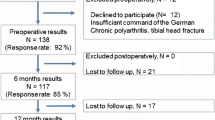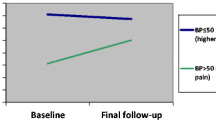Abstract
Depression, somatisation and pain beliefs influence outcome of several painful musculoskeletal disorders. Their influence on the postoperative outcome of total hip replacement was investigated. A total of 79 patients who underwent primary total hip replacement completed questionnaires preoperatively and six weeks postoperatively addressing depression (Hospital Anxiety and Depression Scale–German version), pain beliefs (Pain Beliefs Questionnaire) and somatisation (Screening of Somatoform Disorders-2) as well as outcome [Western Ontario McMaster Universities Osteoarthritis Index (WOMAC), Medical Outcomes Study 36-Item Short Form (SF-36)]. Depressive patients showed a median preoperative WOMAC sum score of 30 compared to 45 in other patients and a postoperative score of 72 compared to 85, and patients with somatoform disorder of 32 compared to 46 preoperatively and 73 versus 86 postoperatively. Patients with high somatisation and depression scores feel worse in their hips and in general well-being before and after surgery, but they experienced the same benefit from total hip replacement as those with low scores.
Résumé
La dépression due à la somatisation et les douleurs résiduelles peuvent influencer le devenir instantané des troubles musculo-squelettique douloureux des prothèses totales de hanches. 79 patients ont bénéficié d’une prothèse totale de hanche et ont rempli un questionnaire préopératoire et à six mois post-opératoire en ce qui concerne la dépression (HADS-D), les douleurs résiduelles (Pain Beliefs Questionnaire) et la somatisation (SOMS-2). Ils ont également rempli le questionnaire WOMAC et le SF-36. Les patients dépressifs montrent un score moyen WOMAC à 30 et ceci peut être comparé au score de 45 pour les autres patients en préopératoire. En postopératoire le score est à 72 comparé aux autres patients qui sont à 85. Les patients somatisant leurs problèmes ont un résultat à 32 comparés à 46 en préopératoire de même en postopératoire, 76 versus 86. Les patients qui présentent une somatisation importante avec une dépression ont une aggravation de leur score avant et après l’intervention mais ils auront le même bénéfice de la prothèse totale de hanche que ceux qui ont un score inférieur.




Similar content being viewed by others
References
Bellamy N, Buchanan WW (1984) Outcome measurement in osteoarthritis clinical trials: the case for standardisation. Clin Rheumatol 3:293–303
Bellamy N (1982) Osteoarthritis—an evaluative index for clinical trials. MSc thesis, McMaster University, Hamilton, Ontario, Canada
Brander VA, Stulberg SD, Adams AD, Harden RN, Bruehl S, Stanos SP, Houle T (2003) Predicting total knee replacement pain: a prospective, observational study. Clin Orthop 416:27–36
Bullinger M, Kirchberger I (1998) SF-36 Fragebogen zum Gesundheitszustand. Hofgrefe Verlag für Psychologie, Göttingen
Edwards LC, Pearce SA, Turner-Stokes L, Jones A (1992) The Pain Beliefs Questionnaire: an investigation of beliefs in the causes and the consequences of pain. Pain 51:267–272
Ethgen O, Bruyère O, Richy F, Dardennes C, Reginster J (2004) Health-related quality of life in total hip and total knee arthroplasty. A qualitative and systematic review of the literature. J Bone Joint Surg Am 86-A:963–974
Herrmann C, Buss U, Snaith RP (1995) HADS-D hospital anxiety and depression scale–Deutsche version. Hans Huber, Bern
Herrmann C (1997) International experiences with the Hospital Anxiety and Depression Scale—a review of validation data and clinical result. J Psychosom Res 42:17–41
Herrmann N, Black SE, Lawrence J, Szekely C, Szalai JP (1998) The Sunnybroke Stroke Study: a prospective study of depressive symptoms and functional outcome. Stroke 29:618–624
Holmes J, House A (2000) Psychiatric illness predicts poor outcome after surgery for hip fracture: a prospective cohort study. Psychol Med 30:921–929
Janis IL (1958) Psychological stress. Wiley, New York
Kimball CP (1969) Psychological responses to the experience of open heart surgery. Am J Psychiatry 126:96–107
Lingard EA, Riddle DL (2007) Impact of psychological distress on pain and function following knee arthroplasty. J Bone Joint Surg Am 89:1161–1169
Magaziner J, Simonsick EM, Kashner M, Hebel JR, Kenzora JE (1990) Predictors of functional recovery one year following hospital discharge for hip fracture: a prospective study. J Gerontol 45:M101–M107
Mossey JM, Knott K, Craik R (1990) The effects of persistent depressive symptoms on hip fracture recovery. J Gerontol 45:M163–168
Mueller-Thomsen T, Tabrizian S, Mittermeier O (2003) Depression bei geriatrischen Patienten mit hüftgelenksnahen Frakturen und deren Auswirkung auf den Rehabilitationsverlauf. Z Gerontol Geriatr 36:138–142
Mutran EJ, Reitzes DC, Mossey J, Fernandez ME (1995) Social support, depression and recovery of walking ability following hip fracture surgery. J Gerontol B Psychol Sci Soc Sci 50:S354–S361
Nickel R, Egle UT, Rompe J, Eysel P, Hoffmann SO (2002) Somatisation predicts the outcome of treatment in patients with low back pain. J Bone Joint Surg Br 84:189–195
Pacault-Legendre V, Anract P, Mathieu M, Courpied JP (2008) Pain after total hip arthroplasty: a psychiatric point of view. Int Orthop. doi:10.1007/s00264-007-0470-2
Rief W, Hiller W, Heuser J (1996) SOMS – Das Screening für Somatoforme Störungen. Hans Huber, Bern
Rief W, Hiller W (2003) A new approach to the assessment of the treatment effects of somatoform disorders. Psychosomatics 44:492–498
Sheehan B, Banerjee S (1999) Review: somatization in the elderly. Int J Geriatr Psychiatry 14:1044–1049
Stucki G, Maier D, Stucki S, Michel BA, Tyndall AG, Dick W, Theiler R (1996) Evaluation einer deutschen Version des WOMAC (Western Ontario and McMaster Universities) Arthroseindex. Z Rheumatol 55:40–49
Walsh DA, Radcliffe JC (2002) Pain beliefs and perceived physical disability of patients with chronic low back pain. Pain 97:23–31
Ware JE Jr, Sherbourne CD (1992) The MOS 36-item short-form health survey (SF-36). I. Conceptual framework and item selection. Med Care 30:473–483
Zigmond AS, Snaith RP (1983) The hospital anxiety and depression scale. Acta Psychiatr Scand 67:361–370
Author information
Authors and Affiliations
Corresponding author
Additional information
No benefits in any form have been received or will be received from a commercial party related directly or indirectly to the subject of this article.
Rights and permissions
About this article
Cite this article
Riediger, W., Doering, S. & Krismer, M. Depression and somatisation influence the outcome of total hip replacement. International Orthopaedics (SICOT) 34, 13–18 (2010). https://doi.org/10.1007/s00264-008-0688-7
Received:
Revised:
Accepted:
Published:
Issue Date:
DOI: https://doi.org/10.1007/s00264-008-0688-7




